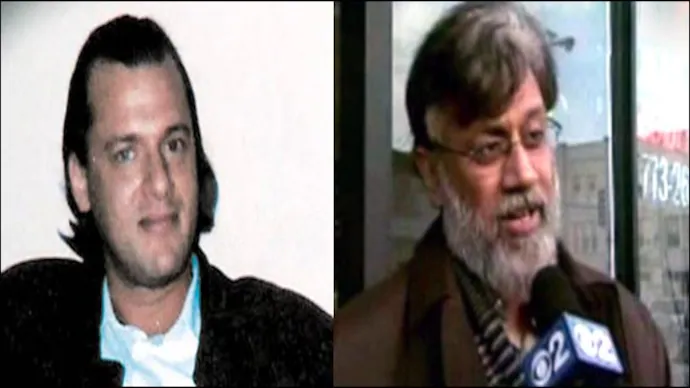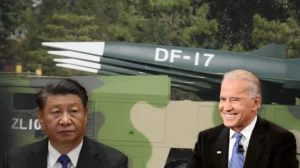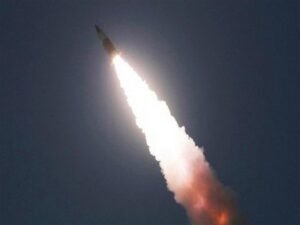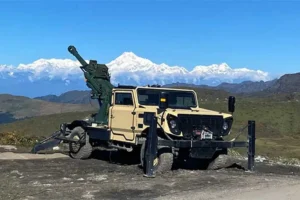Analysis By Aparna Rawal
As India & the world observed the 15th Anniversary of the 2008 Mumbai terror attack this year, the request for the extradition of the alleged terrorist Tahawwur Rana, who was involved in the 2008 Mumbai attacks from the United States, has been delayed.
A federal US court has granted the Pakistani-origin Canadian Tahawwur Rana time till November 9 to file a motion against his extradition to India to face a trial about the 2008 Mumbai terror attack.
The Mumbai attack of 26/11 consumed the lives of 140 Indians and 25 foreign tourists. American and British passport holders were murdered in two hotel complexes while the Israeli nationals were tortured and later killed at a Jewish center. Café Leopold in Colaba, frequented by many foreign nationals, was another target, while Chatrapati Shivaji Terminal became the site of the most significant Indian death toll in the attack.
Why Extradition Of David Headley & Tahawwur Rana From the US Remains A Pipe Dream For India

The orchestrated attack was of a jihadist design; the modus operandi was to wipe out all those who belonged to the nations who opposed Islamic terrorism and to amplify the tension between India and Pakistan.
Soon after the attack, the suspicion was drawn towards LeT. Even though it was assumed that the outfit was banned by Pakistan in 2002, LeT was believed to move and operate freely in Pakistan without any form of interference from the Pakistani authorities.
Over time, it was evident that the Pakistani military had some involvement regarding the conspired attacks as several contradictory statements were made with denials concerning the nationality and background of the terrorists.
Pakistan’s playbook has consistently relied on deniability to avoid accountability for its Gazwa-i-Hind against India.
“When denial doesn’t work, Pakistan takes the plea that the people accused of terrorism are not from Pakistan,” as stated by the Times of Israel.
Regarding the investigation of the Mumbai terror attack, the substantial evidence presented by India to prove the nationality of the terrorists as Pakistani was quickly dispelled by Pakistan by stating that the terrorists were “non-state actors.”
Interestingly enough, not much effort has been made by Pakistan to respond against these ‘non-state actors.’ Instead, it has been observed that the State of Pakistan is habituated to cutting loose and separating itself from these non-state elements through deniability and by lifting all the previous provisions to protect these non-state actors.
As for Tahawwur Rana, he was a former military doctor in the Pakistan Army who moved to Canada after gaining citizenship and became an immigration service businessman. This common knowledge of his background and affiliation with a certain David Headley would undoubtedly raise eyebrows over Rana’s possible association with ISI and the Mumbai attack of 2008.
Tahawwur Rana And David Headley
Rana was born and raised in Chichawatni, Pakistan. He attained his education at the Cadet College Hasan Abdal, a military residential college in Pakistan. It is believed that this is where Tahawwur met Daood Sayed Gilani (aka David Coleman Headley), another Mumbai terror attack conspirator.
Gilani and Tahawwur previously worked together to smuggle heroin to the FATA area. Tahawwur has consistently maintained that he was unaware of the drug trafficking carried by Gilani and was simply an “unwitting shield” to the activities while serving as a military doctor in Pakistan.
However, much can be concluded because it was Rana’s military identity card that Gilani used to gain access to the tribal areas.
After migrating to the US in the ’90s, Rana aided Gilani in smuggling drugs through his First World Immigration Services company in Chicago. The company had other branches in New York and Toronto as well.
By 1997, Tahawwur and his family migrated to Canada, and he soon received his Canadian citizenship.
Meanwhile, in 1988, Gilani was arrested in Frankfurt for possession of two kilos of heroin. Gilani was handed over to the US Drug Enforcement Administration (DEA). He was sentenced to four years in exchange for information on his partners, while his two associates were convicted for longer terms.
In 1997, the DEA, in a sting operation, arrested Gilani for smuggling heroin from Pakistan into the US. A deal was struck yet again. DEA dispatched him to Pakistan to work as an informant for the agency and collect intelligence on Pakistan’s heroin trafficking networks.
While working as an informant for the DEA, Gilani used his status as an asset to provide heroin dealers with jailhouse phone calls that were not under the surveillance of the DEA agents. Gilani was arrested again when he tried to frame a mentally impaired man for the same. However, he was released from prison and given probation for his help in the drug trafficking case and for aiding the DEA in the past.
In February 2002, Gilani attended Lashkar-e-Taiba (LeT) training camps and pursued the outfit’s Jihadist ideologies. In Pakistan, he connected with LeT’s Hafiz Muhammad Saeed and pledged bayat to the outfit’s war on India. This was also supported by the Directorate for Inter-Services Intelligence (ISI).
During his years as a new jihadist, Gilani was arrested several times in domestic violence cases against his wives. In both cases, the wives attested to spousal abuse by him, his involvement and training with terror groups, his anti-Semitism and anti-Hindu prejudice, and his appreciation for the Fidayeen (suicide bombers).
However, it is a surprise how Gilani remained off the radar of the authorities, who viewed the statements of his wives as a mode of grinding their axes against him.
By 2005, Gilani met Sajid Mir, a LeT commander tasked with recruitment in the West. Under his guidance, Gilani is believed to have legally assumed the name David Coleman Headley (mother’s last name).
The idea was to present Headley as a Westerner and remove any suspicion of him being of Pakistani descent. He was expected to pass as a tourist due to his phenotypic features, which looked more Western than that of a Pakistani origin.
This was done to carry out any jihadist task without drawing suspicion from the authorities.
In January 2006, Headley came in contact with Adbur Rehman Hashim “Pasha” Syed, a Major-ranked veteran of the Pakistani military and a LeT militant. Rana was introduced to Major Iqbal.
Iqbal is believed to have utilized his ISI resources to coordinate the LeT activities.
In Headley’s confession, he stated that both Iqbal and Mir became Headley’s ISI handlers and prepped him for the mission to Mumbai to carry out the terror attacks.
Headley acquired US$25,000 from Iqbal and established a Mumbai branch office for Tahawwur Rana’s immigration business. After five significant trips to Mumbai and identifying essential landmarks in Mumbai, the LeT’s plan to orchestrate the terror attack commenced.
During his intelligence gathering for the ISI, Headley received assistance from highly trained Pakistan Navy personnel, helping him locate the best landing spot in South Mumbai.
Like Headley, Tahawwur Rana also maintained that he was in contact with Major Iqbal but has persistently maintained that he had no prior knowledge of the Mumbai attack. However, Headley mentioned having warned him prior of the catastrophe on the way as Tahawwur was expected to visit China and India during that time.
Post-Mumbai Attack
On October 18, 2009, both Rana and Headley were charged and arrested for conspiring to plot attacks on the offices of a newspaper agency called Jyllands-Posten, which was responsible for publishing cartoons of Prophet Mohammad.
It was revealed during the interrogation that Rana had previously visited Mumbai and lodged at the Taj Mahal Hotel, which was one of the sites of the terror attack in 2008. His trial commenced on May 16, 2011, in Chicago, Illinois.
Even though Rana was convicted of abetting with the LeT and for plotting an attack on the newspaper Jyllands-Posten, he was cleared of charges for the 2008 Mumbai attacks. Upon this verdict, India stated that the National Investigative Agency (NIA) would charge Rana in a court in Delhi.

On January 17, 2013, Rana was sentenced to 14 years in prison. David Headley is still serving 35 years in jail and has cooperated with the agencies in revealing critical information regarding LeT, al Qaeda, and ISIS.
Unlike Tahawur, he confessed to his involvement in the Mumbai terror attacks and also detailed his account in a book that he wrote in prison. In 2011, Headley also confessed against Tahawur.
The US has denied the Indian request for extradition of Headley. However, India is still seeking the extradition of Tahawur as per the treaty between the US and India for his offenses.
According to a US court, Rana would remain in US custody until the Secretary of State to India decides on his extradition.
In 2020, Assistant US Attorney John J Lulejian told a federal court in Los Angeles that Rana posed an unacceptable flight risk and pointed out the issues that would stem from Rana and his extradition to India.
What he implied was that if Rana were handed over to India, he would surely be eligible for capital punishment. Since the stakes were against him, Rana would seek other alternatives to escape and avoid extradition.
Also, if Rana were to abscond to Canada (whose nationality he claims), then his extradition from Canada to the US would take several years, and the likelihood of no certainty from the Canadian government at granting the extradition request in the future would undoubtedly pose as an issue.
But, if Canada allowed extradition to the US, based on the US-Canada extradition treaty, the US would be prohibited from extraditing Rana to a third country without Canada’s consent. Under such clauses, Rana becomes a flight risk.
It is essential to mention that the US courts have treated both Headley and Tahawwur differently because Headley, unlike Tahawwur, confessed to the charges and cooperated with the authorities with information in the effort to entrap Sajid Mir.
Tahawwur, on the other hand, has pleaded not guilty and denied the charges against him despite the evidence. In such circumstances, while Headley’s extradition was rejected, there remained a possibility for Tahawwur’s extradition to India.
In May 2023, strongly backed by the Biden Administration and a verdict by a court in the United States, the extradition of Tahawwur Rana to India was approved.
However, in October, the US Ninth Court of Appeals granted Tahawwur Rana to appeal for a stay on the motion to extradite him to India. He was given until November to file an action against the extradition, and the government is expected to announce the decision by December 11.
While Washington is committed to dealing with terrorism globally and advocates for punitive action against the terrorists involved in the 26/11 Mumbai attacks, the matter of extradition of Tahawur remains pending while India continues to wait for Justice.
- Aparna Rawal is an Indian research analyst specializing in the Af/Pak region and counter-terrorism. VIEWS PERSONAL
- The author can be reached at aparnarawal (at) gmail.com







